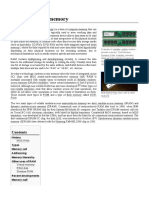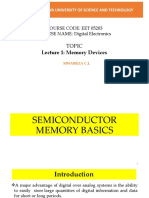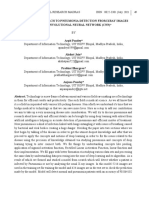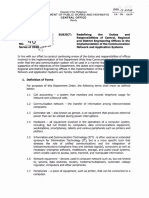Random-access memory
Random-access memory (RAM; /ræm/) is a form of electronic computer
memory that can be read and changed in any order, typically used to store working
data and machine code.[1][2] A random-access memory device allows data items to
be read or written in almost the same amount of time irrespective of the physical
location of data inside the memory, in contrast with other direct-access data storage
media (such as hard disks and magnetic tape), where the time required to read and
write data items varies significantly depending on their physical locations on the
recording medium, due to mechanical limitations such as media rotation speeds and
arm movement.
A 64 bit memory chip die, the SP95
In today's technology, random-access memory takes the form of integrated circuit Phase 2 buffer memory produced at
(IC) chips with MOS (metal–oxide–semiconductor) memory cells. RAM is normally IBM mid-1960s, versus memory
associated with volatile types of memory where stored information is lost if power is core iron rings
removed. The two main types of volatile random-access semiconductor memory are
static random-access memory (SRAM) and dynamic random-access memory
(DRAM).
Non-volatile RAM has also been developed[3] and other types of non-volatile
memories allow random access for read operations, but either do not allow write
operations or have other kinds of limitations. These include most types of ROM and
NOR flash memory.
Example of writable volatile random-
access memory: Synchronous
The use of semiconductor RAM dates back to 1965 when IBM introduced the
dynamic RAM modules, primarily
monolithic (single-chip) 16-bit SP95 SRAM chip for their System/360 Model 95 used as main memory in personal
computer, and Toshiba used bipolar DRAM memory cells for its 180-bit Toscal BC- computers, workstations, and
1411 electronic calculator, both based on bipolar transistors. While it offered higher servers.
speeds than magnetic-core memory, bipolar DRAM could not compete with the
lower price of the then-dominant magnetic-core memory.[4] In 1966, Dr. Robert
Dennard invented modern DRAM architecture in which there's a single MOS
transistor per capacitor.[5] The first commercial DRAM IC chip, the 1K Intel 1103,
was introduced in October 1970. Synchronous dynamic random-access memory
(SDRAM) was reintroduced with the Samsung KM48SL2000 chip in 1992.
History 8GB DDR3 RAM stick with a white
heatsink
Early computers used relays, mechanical counters[6] or delay lines for main memory
functions. Ultrasonic delay lines were serial devices which could only reproduce data in the order it was written. Drum
memory could be expanded at relatively low cost but efficient retrieval of memory items requires knowledge of the
physical layout of the drum to optimize speed. Latches built out of triode vacuum tubes, and later, out of discrete
transistors, were used for smaller and faster memories such as registers. Such registers were relatively large and too
costly to use for large amounts of data; generally only a few dozen or few hundred bits of such memory could be
provided.
The first practical form of random-access memory was the Williams tube. It stored data as electrically charged spots on
the face of a cathode-ray tube. Since the electron beam of the CRT could read and write the spots on the tube in any
order, memory was random access. The capacity of the Williams tube was a few hundred to around a thousand bits, but
it was much smaller, faster, and more power-efficient than using individual vacuum tube latches. Developed at the
University of Manchester in England, the Williams tube provided the medium on which the first electronically stored
program was implemented in the Manchester Baby computer, which first successfully ran a program on 21 June,
1948.[7] In fact, rather than the Williams tube memory being designed for the Baby, the Baby was a testbed to
demonstrate the reliability of the memory.[8][9]

































































































